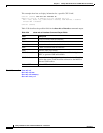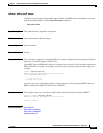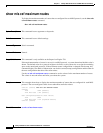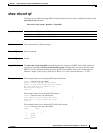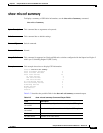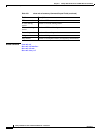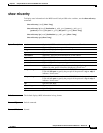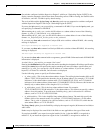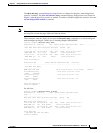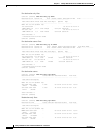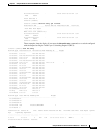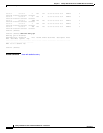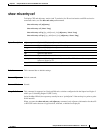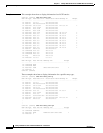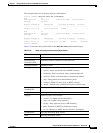
2-970
Catalyst 6500 Series Switch Command Reference—Release 8.4
OL-6244-01
Chapter 2 Catalyst 6500 Series Switch and ROM Monitor Commands
show mls entry
Usage Guidelines On switches configured with the Supervisor Engine 2 with Layer 3 Switching Engine II (PFC2), the
display contains summaries derived from three forwarding sources: FIB for routing, the NetFlow table
for statistics, and ACL TCAM for policy-based routing.
The mod variable and the ip, ipx, long, and short keywords are not supported on switches configured
with the Supervisor Engine 2 with Layer 3 Switching Engine II (PFC2).
If you use the ip keyword, you are specifying a command for IP MLS. If you use the ipx keyword, you
are specifying a command for IPX MLS.
When entering the ip_addr_spec, use the full IP address or a subnet address in one of the following
formats: ip_addr, ip_addr/netmask, or ip_addr/maskbit.
When entering the ipx_addr_spec, use the full IP address or a subnet address in one of the following
formats: src_net/[mask], dest_net.dest_node, or dest_net/mask.
If you enter any show mls command on Catalyst 6500 series switches without IP MLS, this warning
message is displayed:
Multilayer switching not supported on feature card.
If you enter any show mls command on Catalyst 6500 series switches without IPX MLS, this warning
message is displayed:
IPX Multilayer switching not supported on feature card.
If you enter the show mls command with no arguments, general IP MLS information and all IP MLS-RP
information is displayed.
A value 0 for src_port and dst_port means “don’t care.”
Entering the destination keyword specifies the entries matching the destination IP address specification,
entering the source keyword specifies the entries matching the source IP address specification, and
entering an ip_addr_spec can specify a full IP address or a subnet address. If you do not specify a
keyword, it is treated as a wildcard, and all entries are displayed.
Use the following syntax to specify an IP subnet address:
• ip_subnet_addr—This is the short subnet address format. The trailing decimal number 00 in an IP
address YY.YY.YY.00 specifies the boundary for an IP subnet address. For example, 172.22.36.00
indicates a 24-bit subnet address (subnet mask 172.22.36.00/255.255.255.0), and 173.24.00.00
indicates a 16-bit subnet address (subnet mask 173.24.00.00/255.255.0.0). However, this format can
identify only a subnet address with a length of 8, 16, or 24 bits.
• ip_addr/subnet_mask—This is the long subnet address format. For example,
172.22.252.00/255.255.252.00 indicates a 22-bit subnet address. This format can specify a subnet
address of any bit number. To provide more flexibility, the ip_addr is allowed to be a full host
address, such as 172.22.253.1/255.255.252.00.
• ip_addr/maskbits—This is the simplified long subnet address format. The mask bits specify the
number of bits of the network masks. For example, 172.22.252.00/22 indicates a 22-bit subnet
address. The ip_addr is allowed to be a full host address, such as 172.22.254.1/22, which has the
same subnet address as 172.22.252.00/72.
The [long | short] option gives the flexibility to display the output in regular (80 characters in width) or
wide screen.
Dashes may be displayed for some fields if the fields are not applicable to the type of flow mask.
If you place the MSFC on a supervisor engine installed in slot 1, then the MSFC is recognized as
module 15. If you install the supervisor engine in slot 2, the MSFC is recognized as module 16.



